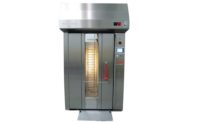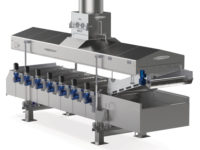Energy efficiency, automation, and ensuring a robust return-on-investment have been top-of-mind for snack food and wholesale bakery companies in the market for ovens and proofers, according to companies that make those machines, who say sales have been strong.
ENERGY EFFICIENCY
AMF Bakery Systems, Richmond, Virginia, is constantly queried about making its ovens and proofers more energy efficient, including converting gas ovens to electric, says Philip Domeniucci, baking system specialist. While AMF can do that, or provide a hybrid electric-gas unit, there are several considerations.
“I’ll put an oven on the moon for you if you give me enough money,” he says. “Designing it is one thing, making it work is another. It’s possible, but we need to take a look at the bigger picture. Where am I going to get the electricity, who’s going to sell it to me, and how is it going to get delivered to me? In the state of Texas, authorities are asking people to turn down the air conditioning during peak hours. While the bakery may be the last industry to shut it off before a regional hospital, at the end of the day, if there’s not enough power, you can’t run the oven.”
Along the same lines, AMF has been following the trend toward using green hydrogen to heat ovens, relying on renewable energy sources such as solar and wind, Domeniucci says. “You can take that energy from electrolyzed water and create hydrogen and oxygen,” he says. “You take the hydrogen, compress it, and store it, and deliver it by truck. AMF has developed a hydrogen burner that can be retrofit into most direct-fired ovens. You can run it as a hydrogen burner or a gas burner, or run it as a blend.”
AMF planned to do its first in-plant testing of this technology at the end of August, Domeniucci adds. “The real holdup has been getting the materials we needed for the burner,” he says.
AUTOMATION
While automation has been on the rise in the snack and bakery industries, certain segments have moved along more quickly than others, Domeniucci says. “If we talk about strictly high speed, hamburger buns, or white bread, that’s already very automated,” he says. “With a smaller wholesale baker, making 40 different products, it become more difficult.”
The pandemic and labor shortages have accelerated the movement toward automation across the board, including within ovens and proofers, says Jerry Barnes, vice president in the North Carolina engineering office at The Babb Group, Raleigh, North Carolina.
“We’re finding that end users are looking for ways to automate as much as possible,” he says. “An oven is fairly automated already, but in the rest of the bakery, we’re seeing a lot of interest in applying automation and areas the typically you’d have had teams of people.”
Customers of Clextral, Firminy, France, have been asking more questions about automation as well, says Gilles Maller, vice president, sales and international. “First of all, they want a very easy interface for operators so they can understand what’s going on, and systems which can be configured very easily,” he says. “Our customers are asking not only that we add precise controls, but also data acquisition—of temperature, recirculation of air, extraction, drying time, all the data they need to optimize their operations.”
CALCULATING ROI
The ability to pull data is critical to calculating return on investment, Domeniucci says. “When someone’s running 18 hours or 20 hours a day nonstop, you can pull a lot of data out of there and find trends that increase efficiencies,” he says. “Being able to monitor and track energy usage has become very important, especially relative to the cost of the dough being produced. All the new ovens we build have that capability.”
When AMF installed two new pizza ovens for a customer in Italy last year, the company guaranteed a 10% reduction in energy and negotiated a bonus if the energy reduction was greater than 12%, Domeniucci says. The customer was very happy to pay that bonus when the reduction exceeded 15%, he says.
“Europeans are more flexible than Americans,” he observes. “Americans don’t want anybody mousing around in their bakery. Very few places are willing to let you put in an Internet connection, strictly because of security. We’ve come up with a number of possibilities to get around that and ease a customer’s fear about somebody hacking into his plant.”
The Babb Group likes to be involved at the early stages of the production line and the process to analyze the requirements of the line from an equipment perspective, Barnes says.
“And then, we either iteratively work with the end-user on the layout for the line, showing where we can eliminate the need for personnel and automate as much as possible, with a clear eye toward, how many people does it take to run this bakery line? How much can we reduce the staffing requirements? How much can we increase up time?” he says. “We assist plants that are struggling with retaining and hiring quality maintenance engineers, bakery personnel and other experts. How do we diagnose situations, minimize downtime, and increase uptime?”
To help determine ROI, Clextral holds thorough discussions with customers about what products they are planning to dry, Maller says. “We need to understand moisture in, moisture out. We also have discussions about the medium of drying—do they want to have electrical or gas dryers?” he says. “From one country or place to another, it might be very different. On top of optimizing the drying cycle, we make sure they’re as efficient as possible—we need to look at gas, electric; with some we use steam. That’s a very important point, as well as looking at the footprint of the factories of our customers.”
SALES LIFTS
The Babb Group has seen greater demand overall, Barnes says. “Especially because the industry we serve was one that consumers turned to during the lockdown stage of the pandemic, and those habits have persisted coming out of the pandemic,” he says. “A lot of users, they don’t always know, two years out, which products will take off in the marketplace. What we’ve tried to do with our ovens is create a highly flexible baking platform. … If market needs change it can be repurposed fairly easily and straightforwardly.”
Clextral also has seen an uptick in orders in the past two years, Maller says, as its high-capacity, modular, hygienic Evolum Plus dryer hit the market. “We did not have in-house, larger dryers for the snack industry with those features,” he says. “This enabled us to tap into the market for large extrusion lines, large snack lines. It’s been a real success, especially in North America.”
Domeniucci has a difficult time saying whether AMF has seen an increase in orders, per se, but he knows the company is “busy like hell” building ovens. “When you talk about selling an oven, somebody doesn’t wake up that morning and say, ‘I better order an oven this week.’ Usually those are multiyear processes,” he says. “Those are not easy sales or easy buys. They take a lot of preparation and a lot of engineering, especially today.” SF&WB
AMF Bakery Systems
SOS Smart Oven Technology
AMF Bakery Systems has developed Sustainable Oven Service (SOS) smart oven technology, a remote monitoring system that connects through a separate internet connection embedded in the equipment itself.
“For the first 30 days [after installation], we just monitor your operation,” Domeniucci says. “What do you do with it every day? How does it run? It allows us to look at the efficiency of the operation. Then we call you up and say, ‘How about we come down for two hours on Monday afternoon?’”
The system can analyze aspects of the process like how cold product coming into the oven is responding to high temperature so the operators can fine-tune it, why there’s a 45-minute gap at 1 a.m. between two dough runs, and how much energy costs in a given week, month, or year, Domeniucci says. “The Sustainable Oven Service monitors the oven to give the customer important feedback on how the oven operates and what he can do to make it operate better,” he says.
The Babb Group
BABBCO Clean Bake Oven
The Babb Group will unveil its updated hybrid tunnel oven, called the Clean Bake Oven, at IBIE, Barnes says. It’s capable of running both gas and electric and switching back and forth. “It allows low risk of entry for customers because their existing process does not have to be modified,” he says. “You have a lot of corporate stakeholders that are demanding everybody pay attention to sustainability objectives, and zero-free carbon emissions. There are a lot of sustainability departments at major companies.”
While the corporate office and C-level executives want those objectives met, the plant team wants to make sure they can produce the same day-to-day quality level, which The Babb Group was mindful of, Barnes says. “We wanted to satisfy both ends of the spectrum from the end-user standpoint,” he says. “It can be used for all snack and bakery products that you can bake in a tunnel oven.”
Clextral
Evolum Plus
The Evolum Plus from Clextral upgraded the company’s relatively simple dryer to one that’s higher capacity, modular, and hygienic, Maller says. The company designed it initially for the breakfast cereal industry, “which is extremely challenging,” he says. “It’s a very sticky product that you need to dry very well.”
That sector is also among the most stringent in terms of wanting hygienic design, which Clextral provided through use of stainless steel, full washdown, and automatic belt cleaning, Maller says. And the modularity enables it to handle widely varying weights, from 500 kilograms to two or three tonnes.
“On top of that, for drying efficiency, we worked with an institute that specializes in airflow and heat treatment, people we have been working with for a very long time,” he says. “As it’s a dryer, it’s potentially dangerous—so we embedded lots of safety devices, like fire detection, gas management, a safety burner, and safety switches. These were key to the design of the dryer.”






